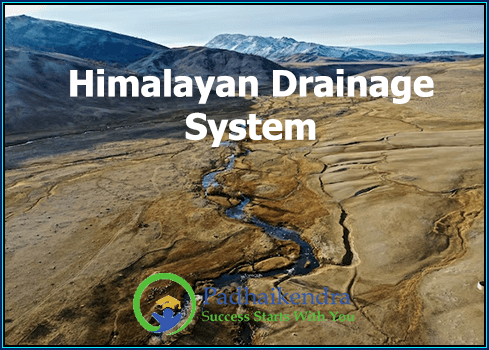The Himalayan Drainage System is a vast network of rivers that originate from the Himalayan mountain range and flow through the northern and northeastern parts of India. These rivers are fed by melting snow and glaciers from the Himalayas, and they serve as a vital source of water for agriculture, industry, and daily life for millions of people in the region.
Indus River System
The Indus River System is a network of rivers and tributaries that flow through India and Pakistan. It is one of the largest river systems in the world and is named after the Indus River, which is the longest and most important river in the system. The Indus River originates in the Tibetan plateau and flows through India before entering Pakistan. It then flows through the length of Pakistan before emptying into the Arabian Sea. The river is an important source of water for irrigation and hydroelectric power generation in both India and Pakistan. The Indus River is also significant for its cultural and historical importance, as it was the site of the ancient Indus Valley Civilization, one of the world’s earliest urban civilizations.
The Indus River System is fed by numerous tributaries, the most important of which are the Jhelum, Chenab, Ravi, Beas, and Sutlej rivers. These rivers originate in the Himalayas and the Punjab region of India before joining the Indus River in Pakistan. The Indus River System is an important source of water for agriculture and industry in both India and Pakistan. It also supports a rich ecosystem, with a variety of fish and bird species found in its waters and wetlands.
The Indus River System has faced numerous challenges in recent years, including dam construction, over-extraction of water, pollution, and climate change. These challenges have affected the river’s flow, water quality, and ecosystem, and have caused concern among environmentalists and communities that rely on the river for their livelihoods. However, efforts are underway to address these challenges and protect the Indus River System for future generations.
The Ganga River System
The Ganga River System is a vast network of rivers and tributaries that flow through India and Bangladesh. The system is named after the Ganges River, which is the most important and sacred river in India and is considered as the lifeline of the northern region of India. The Ganges River originates in the Himalayas at Gangotri Glacier in Uttarakhand, India and flows for over 2,500 km through several Indian states, including Uttarakhand, Uttar Pradesh, Bihar, and West Bengal, before emptying into the Bay of Bengal. The river is considered sacred by Hindus and is worshipped as a goddess in Indian culture. The river is also an important source of water for irrigation and industry in the region.
The Ganga River System is fed by numerous tributaries, the most important of which are the Yamuna, Son, and Ghaghara rivers. The Yamuna River, which originates in the Himalayas, is the largest tributary of the Ganga and flows through several Indian states before joining the Ganga in Uttar Pradesh. The Ghaghara River, also known as the Karnali River, originates in Nepal and flows through Uttar Pradesh and Bihar before joining the Ganga in West Bengal. The Son River, which originates in Chhattisgarh and flows through Bihar and Uttar Pradesh, also joins the Ganga in Uttar Pradesh.
The Ganga River System supports a diverse range of flora and fauna, including several endangered species such as the Ganges river dolphin and the Gharial, a species of crocodile. The river system is also home to several important wetlands, including the Sundarbans delta, which is the largest mangrove forest in the world and a UNESCO World Heritage Site.
Despite its ecological and cultural significance, the Ganga River System faces numerous challenges, including pollution, over-extraction of water, and climate change. The Indian government has launched several initiatives to protect and clean the river, including the Namami Gange program, which aims to rejuvenate the river and its tributaries by reducing pollution, increasing water flow, and improving the river’s ecological health.
Brahmaputra River System
The Brahmaputra River System is a vast network of rivers and tributaries that flows through India, China, and Bangladesh. It is one of the largest river systems in the world and is named after the Brahmaputra River, which is the most important river in the system. The Brahmaputra River originates in Tibet, China, and flows for over 2,900 km through Tibet, India, and Bangladesh before emptying into the Bay of Bengal. In India, the river flows through the northeastern states of Arunachal Pradesh, Assam, and Meghalaya, and is an important source of water for irrigation, fishing, and transportation in the region.
The Brahmaputra River System is fed by numerous tributaries, the most important of which are the Dibang, Subansiri, Kameng, and Manas rivers. The Dibang River originates in Arunachal Pradesh and is the largest tributary of the Brahmaputra River. The Subansiri River, also originating in Arunachal Pradesh, is the second largest tributary of the Brahmaputra River. The Kameng and Manas rivers originate in Bhutan and flow through Arunachal Pradesh and Assam before joining the Brahmaputra River.
The Brahmaputra River System is home to a diverse range of flora and fauna, including several endangered species such as the one-horned rhinoceros, elephant, and tiger. The river system is also home to several important wetlands, including the Kaziranga National Park in Assam, which is a UNESCO World Heritage Site and one of the last remaining habitats of the one-horned rhinoceros.
Despite its ecological and cultural significance, the Brahmaputra River System faces several challenges, including erosion, flooding, and sedimentation. The Indian government has launched several initiatives to address these challenges, including the Brahmaputra Riverine Project, which aims to harness the river’s potential for irrigation, flood control, and navigation. However, these initiatives have also faced criticism from environmentalists and local communities who have raised concerns about the potential impact on the river’s ecosystem and the livelihoods of local communities.





